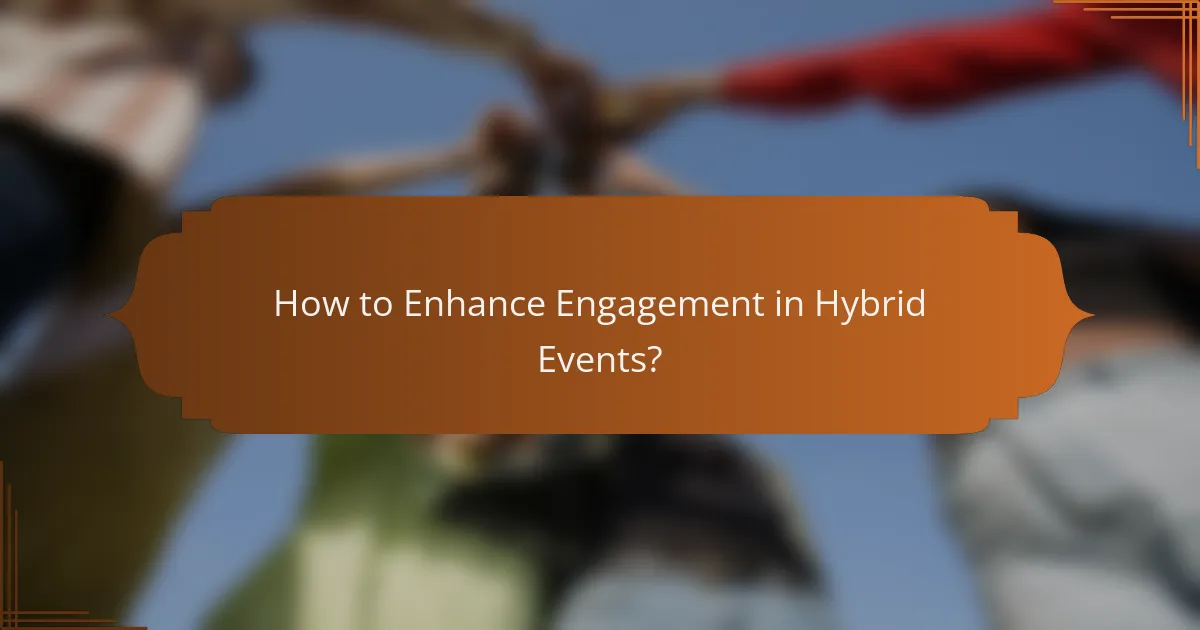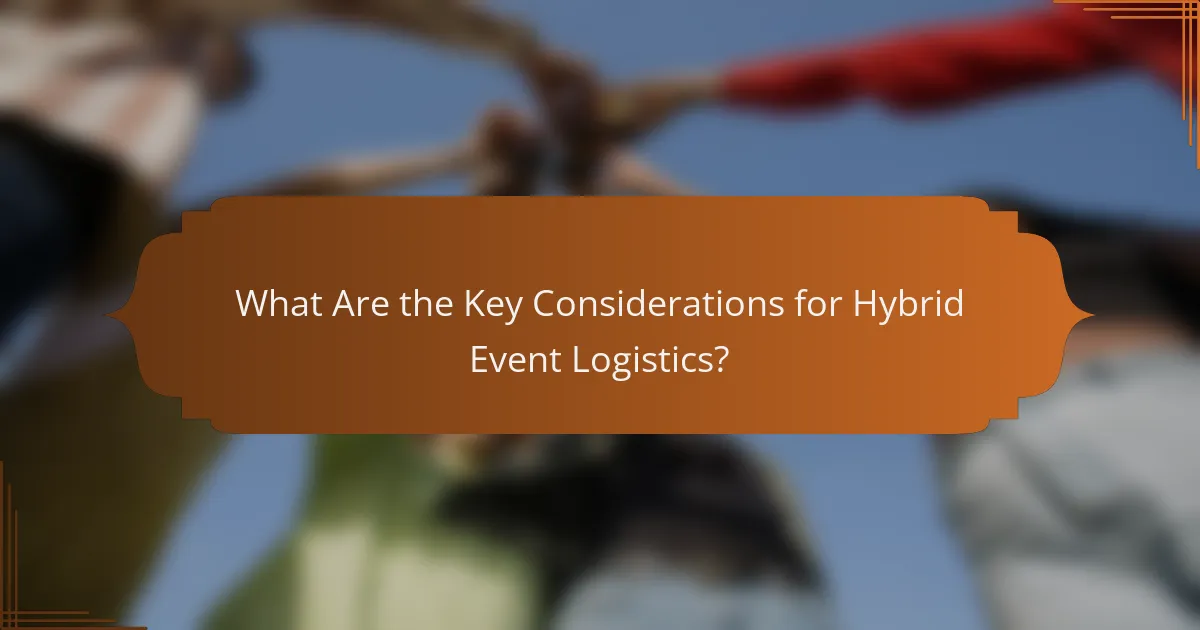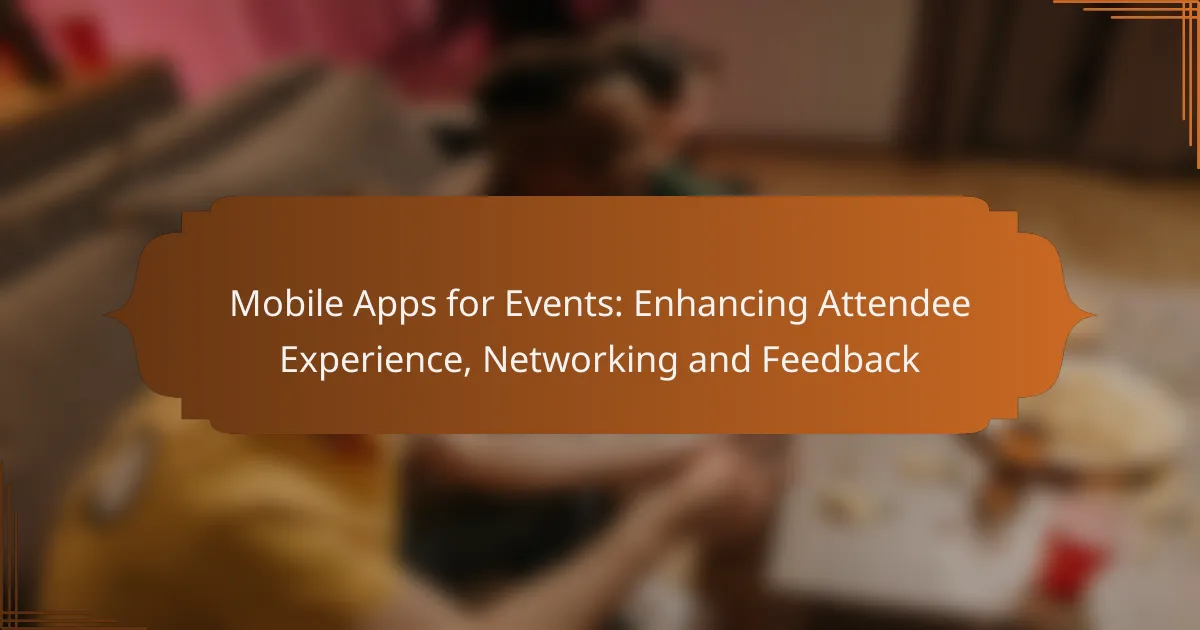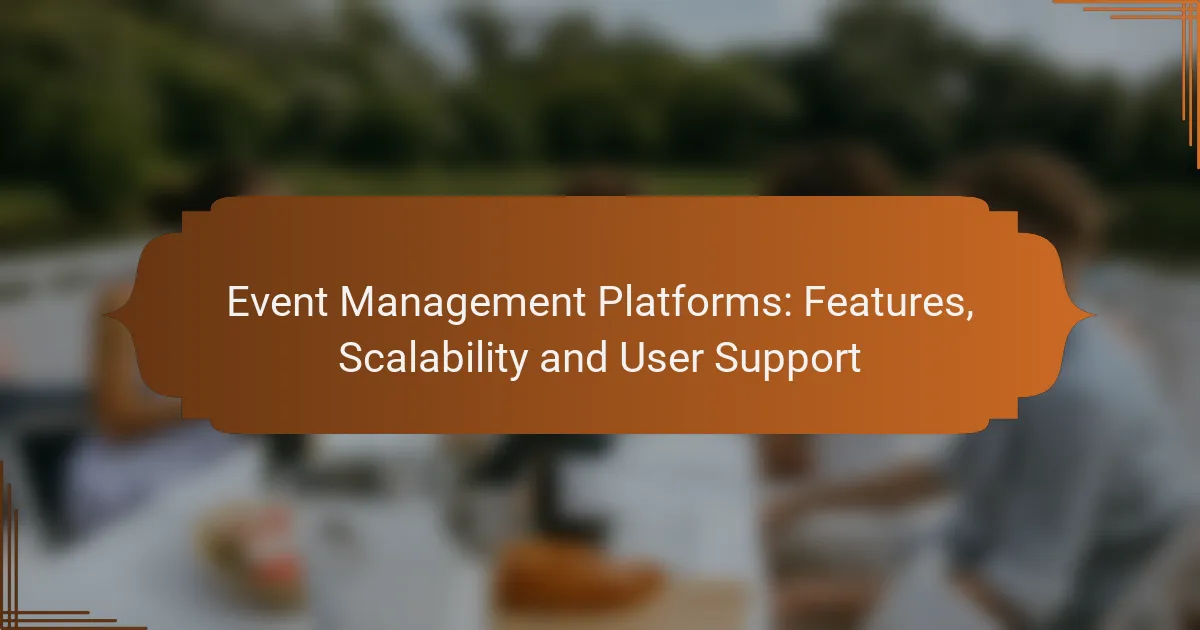In today’s digital landscape, hybrid events have emerged as a powerful way to connect audiences both in-person and virtually. To maximize engagement and create a seamless experience, it’s essential to choose the right platform and implement effective strategies that foster interaction among all attendees. By leveraging technology thoughtfully, organizers can ensure that every participant feels included and valued, regardless of their location.

What Are the Best Platforms for Hybrid Events?
Choosing the right platform for hybrid events is crucial for maximizing engagement and ensuring a seamless experience for both in-person and virtual attendees. The best platforms offer robust features, user-friendly interfaces, and reliable support to facilitate interaction and content delivery.
Zoom Events
Zoom Events is a versatile platform that allows organizers to host virtual and hybrid events with ease. It features breakout rooms, polls, and Q&A sessions, making it ideal for interactive experiences.
Consider using Zoom Events if your audience is already familiar with the Zoom interface, as this can reduce the learning curve. However, be mindful of potential limitations in branding and customization compared to other platforms.
Hopin
Hopin is designed specifically for hybrid events, providing a comprehensive suite of tools for networking, sessions, and expo areas. Its unique layout allows attendees to navigate seamlessly between different event components.
This platform is particularly effective for larger events, as it can accommodate thousands of participants. However, ensure you allocate sufficient time for setup and familiarize yourself with its features to maximize its potential.
Microsoft Teams
Microsoft Teams is an excellent choice for organizations already using Microsoft 365, as it integrates smoothly with other Microsoft applications. It supports live events, webinars, and interactive features like chat and polls.
While Teams is great for internal events, it may lack some advanced features found in dedicated event platforms. If you choose Teams, consider how to engage external participants effectively.
Webex Events
Webex Events offers a robust platform for hosting hybrid events, with features such as live polling, Q&A, and analytics. It is particularly strong in security and compliance, making it suitable for corporate environments.
When using Webex Events, take advantage of its analytics tools to measure engagement and gather feedback. However, be prepared for a steeper learning curve if your team is new to the platform.
vFairs
vFairs specializes in virtual and hybrid trade shows, offering customizable virtual booths and networking lounges. It is particularly effective for exhibitors looking to showcase products and services in an engaging format.
Consider vFairs if your event has a strong focus on exhibition and networking. However, ensure you have the resources to create visually appealing booths, as this can significantly impact attendee experience.

How to Enhance Engagement in Hybrid Events?
Enhancing engagement in hybrid events involves creating interactive experiences that connect both in-person and virtual attendees. Utilizing technology effectively can foster participation and ensure that all attendees feel included and valued.
Interactive Polls
Interactive polls are a powerful tool for boosting engagement during hybrid events. They allow attendees to share their opinions in real-time, making them feel more involved in the discussion. Consider using platforms that integrate seamlessly with your event technology to facilitate easy participation from both in-person and virtual attendees.
When designing polls, keep questions clear and concise. Aim for a mix of multiple-choice and open-ended questions to gather diverse insights. A good practice is to launch polls at key moments, such as after a presentation or during a panel discussion, to maintain momentum and interest.
Live Q&A Sessions
Live Q&A sessions provide an opportunity for attendees to engage directly with speakers, enhancing the overall experience. These sessions can be conducted through chat features or dedicated Q&A platforms, allowing both in-person and virtual participants to submit questions simultaneously.
To manage these sessions effectively, appoint a moderator to filter questions and keep the discussion flowing. Encourage attendees to ask questions early, and consider using a voting system for questions to prioritize the most popular inquiries. This approach ensures that the session remains dynamic and relevant to the audience’s interests.
Virtual Networking Opportunities
Virtual networking opportunities are essential for fostering connections among attendees in hybrid events. These can include breakout rooms, speed networking sessions, or dedicated chat spaces where participants can meet and exchange ideas. Providing structured networking activities can help attendees make meaningful connections.
To maximize the effectiveness of virtual networking, set clear objectives for each session and provide guidelines on how to engage. Consider using icebreaker questions or themes to facilitate conversations. Additionally, ensure that technology is user-friendly to minimize technical difficulties that could hinder interaction.

What Are Effective Strategies for Planning Hybrid Events?
Effective strategies for planning hybrid events involve a blend of in-person and virtual elements that engage all participants. Key considerations include setting clear objectives, selecting appropriate technology, and ensuring seamless integration of experiences for both audiences.
Define Clear Objectives
Establishing clear objectives is essential for the success of hybrid events. Determine what you want to achieve, whether it’s increasing attendance, enhancing engagement, or generating leads. Specific goals help guide decisions throughout the planning process.
Consider using the SMART criteria—Specific, Measurable, Achievable, Relevant, Time-bound—to frame your objectives. For example, aim for a 20% increase in virtual attendance compared to previous events or a specific number of interactions during the event.
Choose the Right Technology
Selecting the right technology is crucial for facilitating a smooth hybrid experience. Look for platforms that support live streaming, audience interaction, and analytics. Popular options include Zoom, Microsoft Teams, and specialized hybrid event platforms like Hopin or Whova.
Evaluate features such as video quality, user interface, and integration capabilities with other tools. Ensure the chosen technology can handle the expected number of participants and provides reliable support for both in-person and virtual attendees.
Integrate In-Person and Virtual Experiences
To create a cohesive experience, integrate in-person and virtual elements effectively. This can involve live streaming sessions, allowing virtual attendees to ask questions in real-time, or using interactive polls that engage both audiences simultaneously.
Consider setting up designated areas for virtual participants to interact with in-person attendees, fostering networking opportunities. Additionally, ensure that all content is accessible to both groups, such as providing recordings of sessions and materials in a shared online space.

What Are the Key Considerations for Hybrid Event Logistics?
Key considerations for hybrid event logistics include venue selection, technical setup, and audience accessibility. Each aspect plays a crucial role in ensuring a seamless experience for both in-person and virtual attendees.
Venue Selection
Choosing the right venue is essential for a successful hybrid event. Look for a location that can accommodate both physical attendees and the necessary technical infrastructure for streaming. Consider venues with experience in hosting hybrid events, as they will likely have the required equipment and support staff.
Evaluate the venue’s layout to ensure that it allows for effective interaction between in-person and online participants. Spaces with good acoustics, lighting, and sightlines can enhance the overall experience. It’s also wise to check for accessibility features to accommodate all attendees.
Technical Setup
A robust technical setup is vital for hybrid events. Ensure you have high-quality audio and video equipment to capture and stream the event effectively. This includes cameras, microphones, and reliable internet connectivity to prevent disruptions during the event.
Consider using a dedicated platform that supports hybrid functionalities, such as live polling, Q&A sessions, and chat features. Test all technology in advance to identify and resolve any potential issues, and have technical support on standby during the event.
Audience Accessibility
Making your hybrid event accessible to all participants is crucial. Provide clear instructions on how to join the virtual component and ensure that the platform is user-friendly. Consider offering closed captioning or sign language interpretation to accommodate diverse needs.
Engage both in-person and virtual audiences by creating opportunities for interaction, such as breakout sessions or networking opportunities. Encourage feedback from both groups to improve future events and ensure that everyone feels included.

How to Measure Success in Hybrid Events?
Measuring success in hybrid events involves evaluating both in-person and virtual participant engagement, satisfaction, and overall event objectives. Key performance indicators (KPIs) should be established before the event to assess effectiveness and areas for improvement.
Engagement Metrics
Engagement metrics are crucial for understanding how participants interact with your hybrid event. These can include attendance rates, session participation, chat activity, and social media mentions. Tracking these metrics helps identify which aspects of the event resonated with attendees.
Consider using tools that provide real-time analytics to monitor engagement levels during the event. For instance, platforms may offer insights into how many attendees are actively participating in polls or discussions, allowing you to adjust your strategy on the fly.
Common pitfalls include focusing solely on attendance numbers without considering the quality of engagement. Aim for a balance between quantitative data, such as the number of questions asked, and qualitative feedback, like post-event surveys to gauge satisfaction and areas for improvement.



